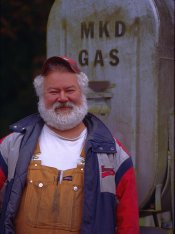keenmaster486
Member
So somehow, miraculously and very unexpectedly, some 13 or 14 people have agreed to be my subjects for a new B&W portraiture project I'm starting. I've taken portraits of people before, but never on such a scale - I plan to shoot upwards of 200 frames total.
So I really would like some advice on this as my experience is limited. The subjects will be choosing the locations and time of day, so I will have a range of films available - for 35mm, some Pan F 50, T-Max 100, Fomapan 100 & 400, and Delta 3200, and in 120, only Fomapan 100. I can handle the developing with my Patterson tank and D-76.
Here are the cameras I will have available:
35mm:
-Kodak Retina IIa
-Voigtlander Vitessa L
-Zeiss Contaflex Beta
-(possibly, currently occupied with some Velvia) Regula Cita
-Pentax P30T with 28-80mm lens
120:
-Voigtlander Bessa I
-Kodak Duaflex II with focusing lens (do I really want to use this one? maybe for some situations, I might decide simpler is better?)
My plan is to scan all of the frames using my DSLR and a light table, and then choose the best ones of the bunch and print them very large on multigrade paper. I have a friend who is experienced in printing and has kindly offered the use of his darkroom the next time he does a batch of prints. If I find an enlarger for a good price in the area, I might also do some on my own.
My main worry is the actual shooting - am I up to the task? Like I said, I've taken portraits before, I've been shooting film since I was a kid, I have a good grasp of how to operate these cameras and the basic concepts of photography, but I worry about composition and timing.
Here are some shots I took around New Years time of my sister, with the Contaflex and Fomapan 400 (crappy lab scans, but you get the idea, these are fairly representative of how I take pictures):
Dead Link Removed
Dead Link Removed
Dead Link Removed
Dead Link Removed
Dead Link Removed
Dead Link Removed
Dead Link Removed
Dead Link Removed
Dead Link Removed
Dead Link Removed
Dead Link Removed
Dead Link Removed
Dead Link Removed
Dead Link Removed
I didn't really feel like I knew what I was doing, but some of them look pretty good, I guess.
I would deeply appreciate any advice those of you who know more than I do can give me. I want to put everything I've got into this project. I hope I'm not in over my head.
Thanks everyone!
So I really would like some advice on this as my experience is limited. The subjects will be choosing the locations and time of day, so I will have a range of films available - for 35mm, some Pan F 50, T-Max 100, Fomapan 100 & 400, and Delta 3200, and in 120, only Fomapan 100. I can handle the developing with my Patterson tank and D-76.
Here are the cameras I will have available:
35mm:
-Kodak Retina IIa
-Voigtlander Vitessa L
-Zeiss Contaflex Beta
-(possibly, currently occupied with some Velvia) Regula Cita
-Pentax P30T with 28-80mm lens
120:
-Voigtlander Bessa I
-Kodak Duaflex II with focusing lens (do I really want to use this one? maybe for some situations, I might decide simpler is better?)
My plan is to scan all of the frames using my DSLR and a light table, and then choose the best ones of the bunch and print them very large on multigrade paper. I have a friend who is experienced in printing and has kindly offered the use of his darkroom the next time he does a batch of prints. If I find an enlarger for a good price in the area, I might also do some on my own.
My main worry is the actual shooting - am I up to the task? Like I said, I've taken portraits before, I've been shooting film since I was a kid, I have a good grasp of how to operate these cameras and the basic concepts of photography, but I worry about composition and timing.
Here are some shots I took around New Years time of my sister, with the Contaflex and Fomapan 400 (crappy lab scans, but you get the idea, these are fairly representative of how I take pictures):
Dead Link Removed
Dead Link Removed
Dead Link Removed
Dead Link Removed
Dead Link Removed
Dead Link Removed
Dead Link Removed
Dead Link Removed
Dead Link Removed
Dead Link Removed
Dead Link Removed
Dead Link Removed
Dead Link Removed
Dead Link Removed
I didn't really feel like I knew what I was doing, but some of them look pretty good, I guess.
I would deeply appreciate any advice those of you who know more than I do can give me. I want to put everything I've got into this project. I hope I'm not in over my head.
Thanks everyone!







 f the whole process
f the whole process